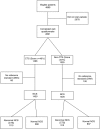Prospective analysis of the accuracy of diagnosis of carpal tunnel syndrome using a web-based questionnaire
- PMID: 25142261
- PMCID: PMC4139658
- DOI: 10.1136/bmjopen-2014-005141
Prospective analysis of the accuracy of diagnosis of carpal tunnel syndrome using a web-based questionnaire
Abstract
Objective: To confirm the accuracy of a diagnostic questionnaire for carpal tunnel syndrome (CTS) when presented via a public website rather than on paper.
Design: Prospective comparison of the probability of CTS as assessed by the web-based questionnaire at http://www.carpal-tunnel.net with the results of nerve conduction studies.
Setting: Subregional neurophysiology laboratory serving a population of 700,000 in East Kent, UK.
Participants: 2821 individuals who were able to complete an online diagnostic questionnaire out of 4899 referred for initial diagnostic testing for new presentations with suspected CTS from April 2011 to March 2013. No exclusions were made on grounds of age, gender or coincident pathology. Main outcome measure--nerve conduction results confirming CTS. The severity of median nerve impairment demonstrated was also assessed using a validated neurophysiological scale.
Results: The web-based questionnaire accurately estimates the probability of CTS being confirmed on nerve conduction studies. Using a website diagnostic score of ≥40% as an example cut-off value the questionnaire achieves 78% sensitivity and 68% specificity in predicting the finding of evidence of CTS on nerve conduction studies. The web-based version of the diagnostic questionnaire was as accurate as the original paper version with an area under the receiver operating characteristic curve of 0.79. There was also a significant correlation between the diagnostic score given by the website and the severity of CTS with higher scores being associated with greater nerve dysfunction (r=0.3, p<0.00001).
Conclusions: Completion of the symptom questionnaire on the website by patients at home provides a prediction of the likelihood of CTS which is sufficiently accurate to be used in initial planning of investigation and treatment.
Keywords: Carpal Tunnel Syndrome; Diagnosis; Questionnaire; Sensitivity and Specificity; World Wide Web.
Published by the BMJ Publishing Group Limited. For permission to use (where not already granted under a licence) please go to http://group.bmj.com/group/rights-licensing/permissions.
Figures




References
-
- Jenkins MA, Clarke JR, Carlin JB, et al. Validation of questionnaire and bronchial hyperresponsiveness against respiratory physician assessment in the diagnosis of asthma. Int J Epidemiol 1992;25:609–16 - PubMed
-
- Allen RP, Burchell BJ, MacDonald B, et al. Validation of the self-completed Cambridge-Hopkins questionnaire (CH-RLSq) for ascertainment of restless legs syndrome (RLS) in a population survey. Sleep Med 2009;10:1097–100 - PubMed
-
- Bland JDP. The value of the history in the diagnosis of carpal tunnel syndrome. J Hand Surg Br 2000;25B:445–50 - PubMed
-
- Bland JD, Weller P, Rudolfer S. Questionnaire tools for the diagnosis of carpal tunnel syndrome from the patient history. Muscle Nerve 2011;44:757–62 - PubMed
-
- Jablecki CK, Andary MT, Floeter MK, et al. Practice parameter: electrodiagnostic studies in carpal tunnel syndrome. Neurology 2002;58:1589–92 - PubMed
MeSH terms
LinkOut - more resources
Full Text Sources
Other Literature Sources
Medical
Research Materials
Miscellaneous
